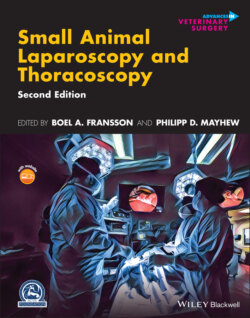Читать книгу Small Animal Laparoscopy and Thoracoscopy - Группа авторов - Страница 106
Veress Needle Technique
ОглавлениеThe Veress needle technique is the oldest and the most traditional technique. One large retrospective study revealed that 81% of 155 987 gynecologic laparoscopic procedures used the Veress needle technique, but only 48% of 17 216 general surgical laparoscopic procedures used this method of insufflation [4]. The Veress needle is a specially designed instrument with an outer diameter of approximately 2 mm (Figure 4.16). The outer cannula consists of a beveled needle point for cutting through tissue and an inner spring‐loaded dull‐tipped stylet (Figure 4.17). After the sharp outer needle passes through the abdominal wall, the spring‐loaded stylet springs forward to protect the inner organs. The needle can then be attached to insufflation tubing and CO2 used to inflate the cavity. Blind placement of a Veress needle remains an important risk factor for complications. There are multiple reported safety tests to confirm that the Veress needle is properly placed before insufflation, including the “double click sound,” “aspiration test,” “hiss sound test,” “waggle test,” and “hanging drop test.” Unfortunately, most of these tests have been shown to be unreliable [5]. In fact, waggling the Veress needle from side to side was considered contraindicated in clinical guidelines for MD surgeons because of the risk of organ laceration [6]. Two studies have looked at the diagnostic accuracy of tissue impedance measurement interpretation for correct Veress needle placement in cats and dogs [7, 8]. In dogs, the impedance measurement had a 89.7% sensitivity, 100% specificity, and 90% accuracy [7]. In cats, tissue impedance measurement resulted in 94.7% sensitivity, 20% specificity, and 79.2% accuracy [8]. The differences between cats and dogs were thought to be due to the overdeveloped retroperitoneal fat pad in cats as well as their small size. A recent study also looked at not only different Veress needle types but also different positions for safe placement into the abdomen to decrease penetration to abdominal organs [9]. The results of this study recommended placement of the Veress needle at the 9th intercostal space over para‐, supra‐ and subumbilical positions [9].
Figure 4.16 Veress needle.
Source: © 2014 Photo courtesy of KARL STORZ SE & CO, KG.
Figure 4.17 Close up photograph of the specialized tip to a Veress needle.
Source: © 2014 Photo courtesy of KARL STORZ SE & CO, KG.
After an adequate volume of gas has been insufflated, the Veress needle is removed. In the blind technique for initial trocar insertion, a bladed trocar or trocar with a sharp obturator is inserted through an adequately sized incision. Trocar assemblies with sharp obturators are most commonly used in veterinary medicine; laparoscopic surgeons in human medicine tend to use bladed trocars. Bladed trocars are equipped with a spring‐loaded safety shield that retracts when passed through the abdominal wall. This is often accompanied by an audible click as the blade retracts. Advancement of the trocar assembly is stopped at this point, and the bladed trocar or sharp obturator is removed from its outer cannula. The laparoscope can then be inserted to confirm the successful placement of the cannula in the peritoneal cavity and to rule out intraabdominal injury from either Veress needle or trocar insertion. If the cannula is appropriately located, the insufflation tubing is connected to the gas port of the cannula, and insufflation to the predetermined pressure occurs. The remaining cannulas are then placed under direct visualization.
